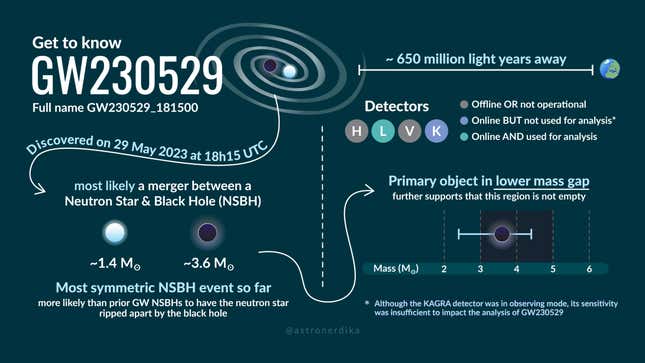A number one gravitational wave observatory just lately detected ripples in space-time that scientists say have been brought on by the collision of a useless, super-dense star remnant and an unknown object.
A stellar remnant is what is known as a neutron star; it’s what’s left behind when a large star collapses, abandoning solely a dense core. Neutron stars are among the densest objects within the Universe, with intense gravitational fields, however not as intense as black holes, whose gravity is so robust that not even gentle can escape their occasion horizons.
These two cosmic giants dance and collide within the Universe; The primary affirmation of the noticed merger of a neutron star and a black gap was obtained. made in 2021. Their interactions produce gravitational waves—actually the stretching and contraction of spacetime—which might be detected by observatories such because the LIGO-Virgo-KAGRA collaboration, which is on the coronary heart of the most recent analysis.
LIGO-Virgo-KAGRA detected a gravitational wave sign in Could 2023, simply days after the observatory has resumed work following some updates that lowered the quantity of noise within the detector and improved its sensitivity to refined perturbations in spacetime.
The distinctive gravitational wave sign traveled 650 million gentle years to achieve LIGO’s Livingston Observatory in Louisiana. The researchers decided that the sign got here from the merger of two objects. One of many objects had a mass of 1.2 to 2 occasions our Solar, and the opposite had a mass of two.5 to 4.5 photo voltaic lots. The sign was named GW230529_181500 or GW230529 for brief.
Astrophysicists have concluded that the smaller object is probably going a neutron star. However the bigger object is extra huge than any recognized neutron star, indicating it could possibly be a tiny black gap. Their paper describing the sign and its probably origin, presently posted on the LIGO web site.
The unknown object occupies the obvious mass distinction that exists between the heaviest recognized neutron star and the lightest black gap. Additional research of the collision will reveal whether or not the unknown object is a low-mass black gap, because the staff suspects, or one thing else.
The invention “reveals that the probability of comparable collisions between neutron stars and low-mass black holes could also be larger than we beforehand thought,” mentioned Jess McIver, an astronomer on the College of British Columbia and deputy consultant of the LIGO science collaboration. in cooperation launch.
The press launch notes that of practically 200 measurements of the lots of compact objects, just one merger concerned an object in a visual mass hole—a merger with a black gap. (For gravitational wave geeks, that sign was GW190814.) However the latest statement was the primary between an object with a mass distinction and a neutron star.
The fourth LIGO-Virgo-KAGRA observing cycle will resume on April 10 and can proceed with out deliberate interruptions till February 2025, when the collaboration expects to have detected greater than 200 gravitational wave alerts.

It has been a productive few years for gravitational wave science, with extra curiosity on the horizon. Final 12 months, a number of pulsar synchronization consortia independently confirmed the primary indicators of gravitational wave background— a relentless murmur of gravitational waves all through the universe, which they consider comes from the dancing of supermassive binary black holes.
Earlier this 12 months, ESA formally approves LISA plans, space-based gravitational wave observatory. LISA will encompass three spacecraft rotating in house in a triangular formation. LISA will hear for gravitational waves with none of the Earth-based noise that may contaminate the information collected by LIGO-Virgo-KAGRA.
There are one other 80 essential candidates that the staff wants to research. So we’ve got thrilling days forward for observing the gravitational Universe.
Extra: These violent collisions might result in the formation of darkish matter
